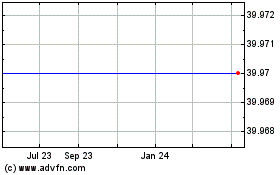MARKET SNAPSHOT: Stocks Open Sharply Lower After Weak Private Payrolls Report
October 02 2019 - 10:08AM
Dow Jones News
By Mark DeCambre, MarketWatch , Andrea Riquier
Dow and S&P 500 both now below 100-day moving averages
U.S. stocks opened lower on Wednesday after a reading of
private-sector employment affirmed that hiring was slowing. That
report came after Wall Street was rattled Tuesday by the worst
reading on American factories since 2009, along with data showing
global manufacturing has now shrunk for the fifth month in a
row.
What did major indexes do?
The Dow Jones Industrial Average opened 180 points lower, or
0.7%, to open at 26,395 while the S&P 500 index fell about 20
points or 0.7%, opening at 2,920. The Nasdaq lost 62 points, 0.8%
at the open, touching 7,847.
The Dow and S&P 500 have now both broken below their 100-day
moving averages.
On Tuesday, the Dow lost 344 points, or 1.3%, to finish
26,573.04, the S&P 500 fell 37 points, or 1.2%, to end at
2,940.25. The Nasdaq Composite Index retreated 91 points, or 1.1%,
to close at 7,908.68. The small-capitalization Russell 2000 index
saw a steeper drop, losing 1.9% to 1,493.43. The S&P 500 closed
below its 50-day moving average for the first time since Sept.
4.
What's driving the market?
A private-sector employment report
(http://www.marketwatch.com/story/adp-says-135000-private-sector-jobs-created-in-september-as-hiring-continues-to-slow-2019-10-02)
from Automatic Data Processing showed that a modest 135,000 jobs
were created in September, another sign that hiring is slowing
along with the broader U.S. economy. That missed the Econoday
consensus forecast of 152,000 jobs. The average monthly job growth
for the past three months also fell to 145,000 from 214,000 for the
same time period last year.
That followed a Tuesday release of the JPMorgan IHS global
manufacturing index
(https://www.markiteconomics.com/Public/Home/PressRelease/6d5ffb41584d4c08a54706d85d3580b3)for
September, which remained below 50, signalling contraction, for a
fifth straight month.
"Bottom line: as expected. Equity futures were already lower
ahead of these data," said Scott Brown, chief economist for Raymond
James, after the ADP report was released.
The ADP payrolls report is published ahead of the more closely
followed U.S. Labor Department's nonfarm-payroll report due on
Friday.
Signs of weakness in the U.S. economy may prompt the Federal
Reserve to further lower interest rates at its late October
meeting, after two quarter percentage point cuts in back-to-back
central-bank policy meetings, market participants said.
Which stocks are in focus?
Johnson & Johnson(JNJ) shares rose nearly 3% after the
company cut a deal to avoid an upcoming opioid litigation
trial.
Shares of pharmaceutical company Savara Inc.(SVRA) tumbled 47%
in morning trading after the company said the U.S. Food and Drug
Administration had found its application for a new medication
insufficient.
Discount-broker stocks continued to fall after the Tuesday
announcement by Charles Schwab Corp.(SCHW) that it would cut most
trading commissions to zero
(http://www.marketwatch.com/story/can-it-get-any-cheaper-to-be-an-investor-2019-10-01).
TD Ameritrade Holdings Corp.(AMTD) lost 3% in early-morning
trading.
How did other markets trade?
The yield on the 10-year U.S. Treasury note was down nearly 4
basis points to 1.61% on Wednesday morning.
In commodities markets, West Texas Intermediate crude-oil for
November delivery was down 13 cents, about 0.2%, to $53.53 a barrel
on the New York Mercantile Exchange.
Gold for December delivery jumped $13.10, nearly 0.9%, to reach
$1,502.50 an ounce.
In Asia, Chinese equity benchmarks were closed in observance of
the 70th anniversary of Communist rule. Japan's Nikkei 225
meanwhile, fell 0.5%, wiping out a similar loss from Monday.
European stocks traded lower, with the Stoxx Europe 600 down
1.6%.
(END) Dow Jones Newswires
October 02, 2019 09:53 ET (13:53 GMT)
Copyright (c) 2019 Dow Jones & Company, Inc.
TD Ameritrade (NASDAQ:AMTD)
Historical Stock Chart
From Mar 2024 to Apr 2024

TD Ameritrade (NASDAQ:AMTD)
Historical Stock Chart
From Apr 2023 to Apr 2024
